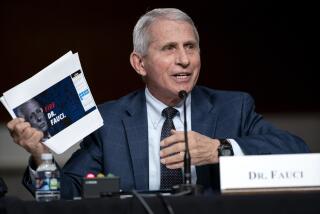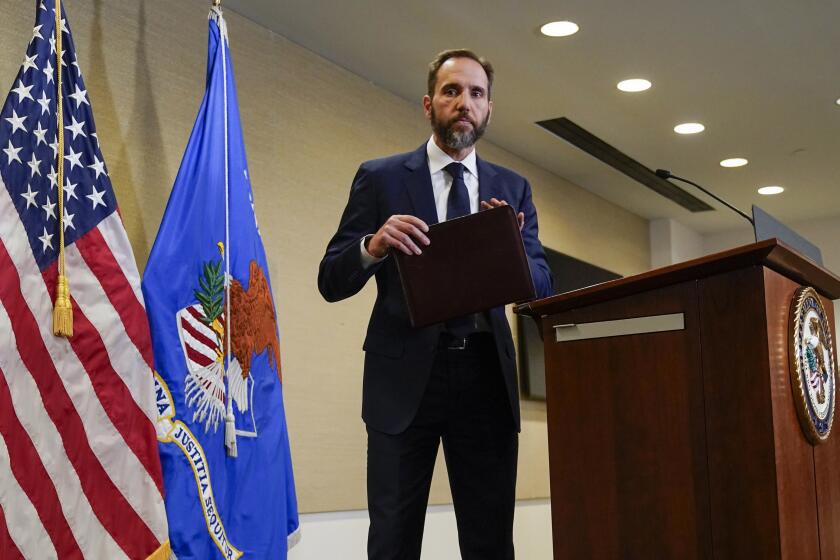Op-Ed: AIDS at 30: Apathy plus HIV kills
It was a chilly spring day in Washington when Secretary of Health and Human Services Margaret Heckler made a historic announcement. “The probable cause of AIDS has been found,” she began, “a variant of a known human cancer virus.” It was 1984, and she confidently declared that a vaccine would be available within two years. It was a statement of hope rather than science.
Researchers in France and the United States had discovered what was behind the AIDS epidemic, and the news was not as promising as Heckler would have the public believe. Yes, it was a virus, but not just any virus. The retrovirus discovered that year, later named HIV, is part of a family of viruses known to camouflage themselves within human DNA. No one knew how to treat them. For most virologists, the end of the epidemic seemed far away. When Heckler made the stunning announcement in 1984, perhaps her forceful language was compensation for years of White House inaction.
In 1982 a reporter at a White House briefing asked President Reagan’s press secretary, Larry Speakes, if the president had any reaction to the AIDS crisis. He responded, “What’s AIDS?” The reporter said that it was known as the “gay plague” and was responsible for hundreds of deaths. The room erupted in laughter. Speakes brushed off the question as a playful lark. Reagan did not make his first major speech on the issue until May 1987. By then, the epidemic had spread to 113 nations, 36,000 Americans were infected with HIV, and 21,000 Americans had died from AIDS.
In 1984, the stigma associated with HIV was crushing. Some of those we depend on most in an emergency — firefighters, police officers, doctors and hospitals — refused to take care of people with HIV. Those with AIDS found the physical manifestations of the disease — sunken cheeks and purplish pock marks called Kaposi’s sarcoma — isolating. HIV-positive children, notably Ryan White, were banned from school.
The virus brought the ugliness of homophobia to light. Insidiously, it even invaded our science. Some researchers refrained from working on the disease because of its association with gay men. Others found themselves having to defend their work on a disease perceived by critics as a lifestyle choice. Dr. Anthony Fauci, today the head of the National Institutes of Allergies and Infectious Disease, famously rebutted detractors when he said, “What lifestyle did the fetus undertake to acquire the disease?”
In the 30 years since we discovered HIV, the stigma surrounding it has lessened, but it has never completely dissipated. And new threats loom: apathy and ignorance. AIDS advocacy groups are suffering from “prevention fatigue.” The waning interest in prevention has propelled rising HIV infections in adolescents and young adults in comparison with other age groups. Of the estimated 1.1 million Americans living with HIV, the Centers for Disease Control and Prevention suggests that 16% do not know their HIV status. This number is significantly higher for those aged 13 to 24; 60% of these individuals don’t know they are infected. Young adults are also more likely to delay treatment, waiting until the virus causes irreparable damage to the body.
We’ve also seen the rise of what AIDS policy advocates call “HIV shaming” — situations in which gay men openly discriminate against those with HIV. A generation far removed from the dark days of the disease may not realize that more than 1 million lives are still lost to AIDS annually.
In the midst of the cultural lethargy surrounding HIV, the science has never been stronger. Today, thanks to new therapies, people with HIV can live long, healthy lives.
There is a small group of patients whose HIV has been cured by radical therapies and whose experiences have fueled promising clinical trials. After two infants were cleared of the virus, we have new hope for eradicating HIV in children.
A drug called Truvada reportedly is able to reduce the risk of becoming infected with HIV by 75%. But it’s used by only a small percentage of those who could benefit from it. The drug has suffered from a poor reputation because some derisively call it a “party drug” and those who take it “Truvada whores.” It’s become a sad example of how cultural attitudes can hamper medicine.
Thirty years ago, Dr. Robert Gallo, the co-discoverer of HIV, stood next to Heckler at that news conference. He felt uneasy when he heard Heckler say that a vaccine would be available in two years. Over the next three decades many guarantees would be made about HIV, almost all of them empty promises. Yet today, Gallo sees the situation finally changing. He says that a “functional cure, I believe, is definitely achievable.”
And in December, the White House announced a $100-million initiative toward finding a cure for HIV. This investment has the potential to make an enormous difference. But research is only one piece of the puzzle. Our ability to treat and cure HIV in the future is threatened by the continued stigma, apathy and ignorance surrounding the virus. HIV at 30 still has a long way to go.
Nathalia Holt is a research scientist and the author of “Cured: How the Berlin Patients Defeated HIV and Forever Changed Medical Science.”
More to Read
A cure for the common opinion
Get thought-provoking perspectives with our weekly newsletter.
You may occasionally receive promotional content from the Los Angeles Times.










